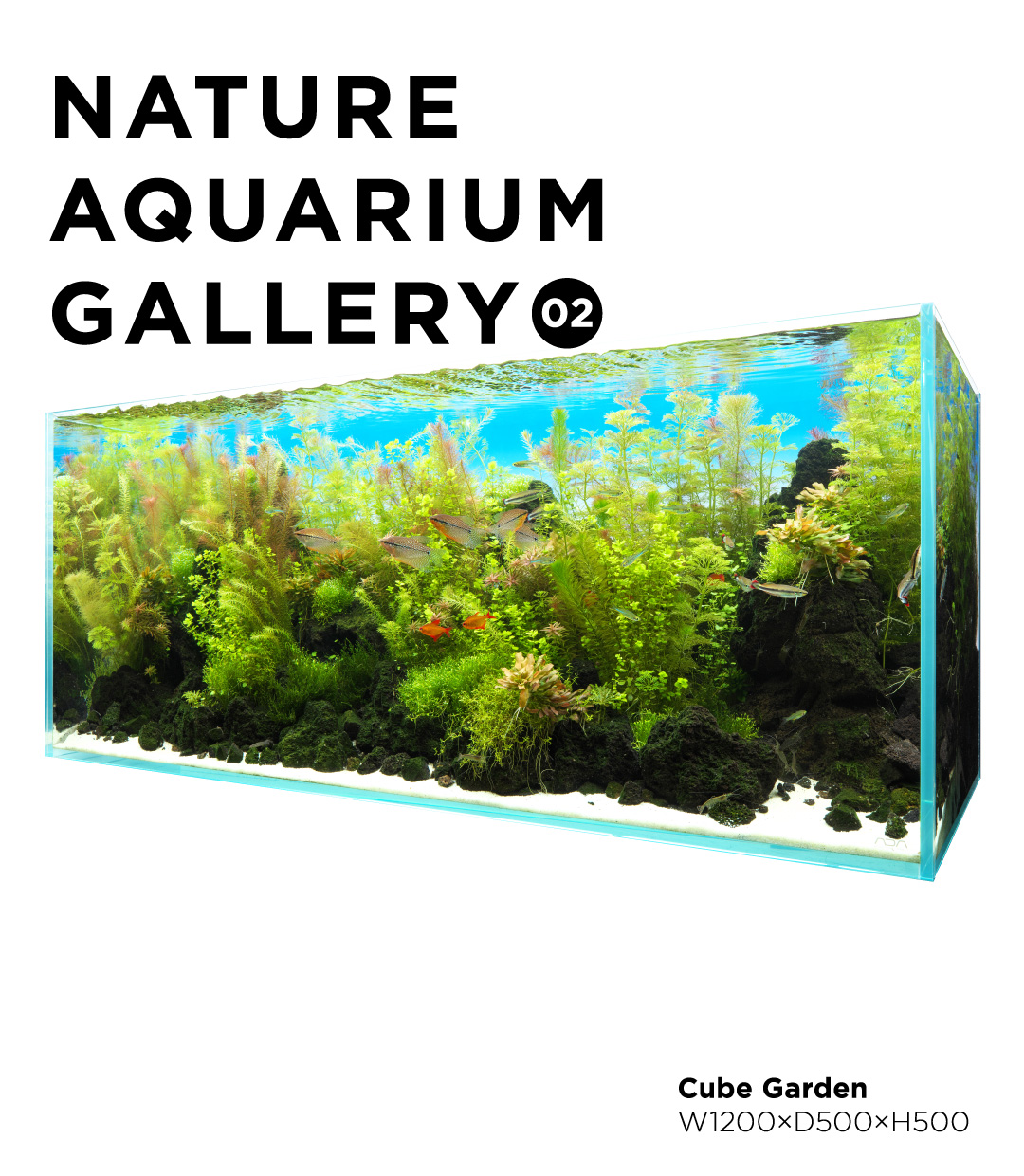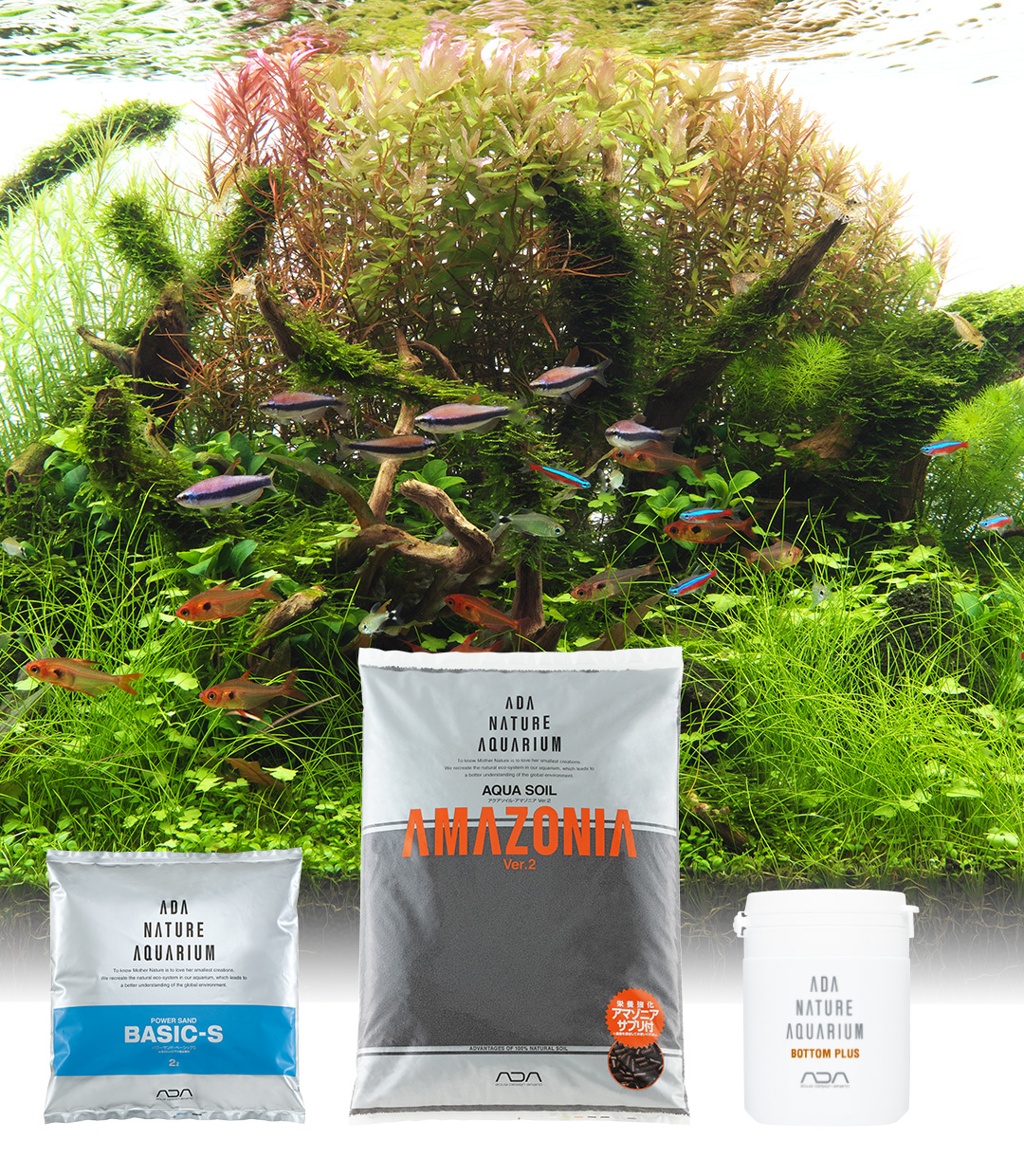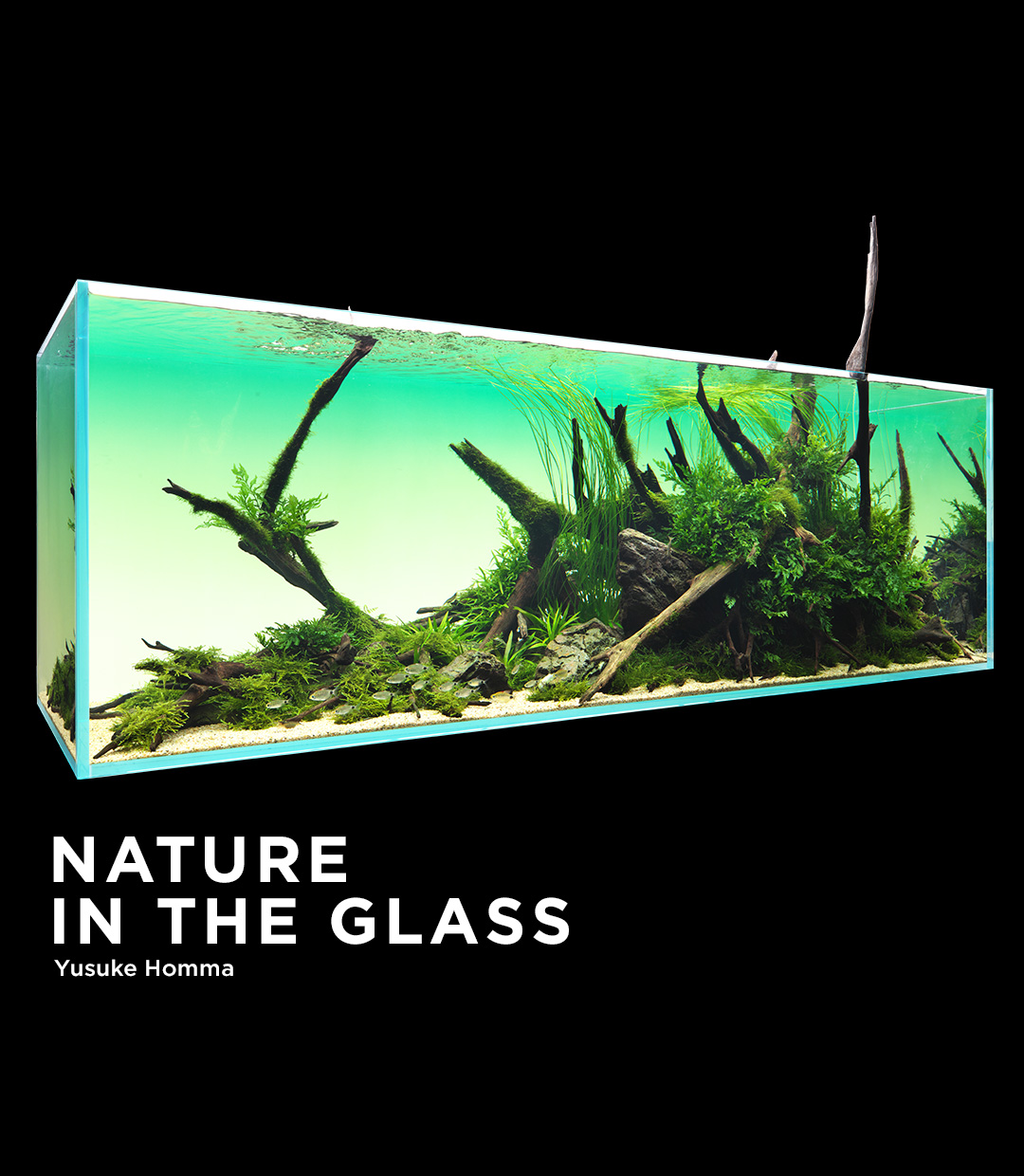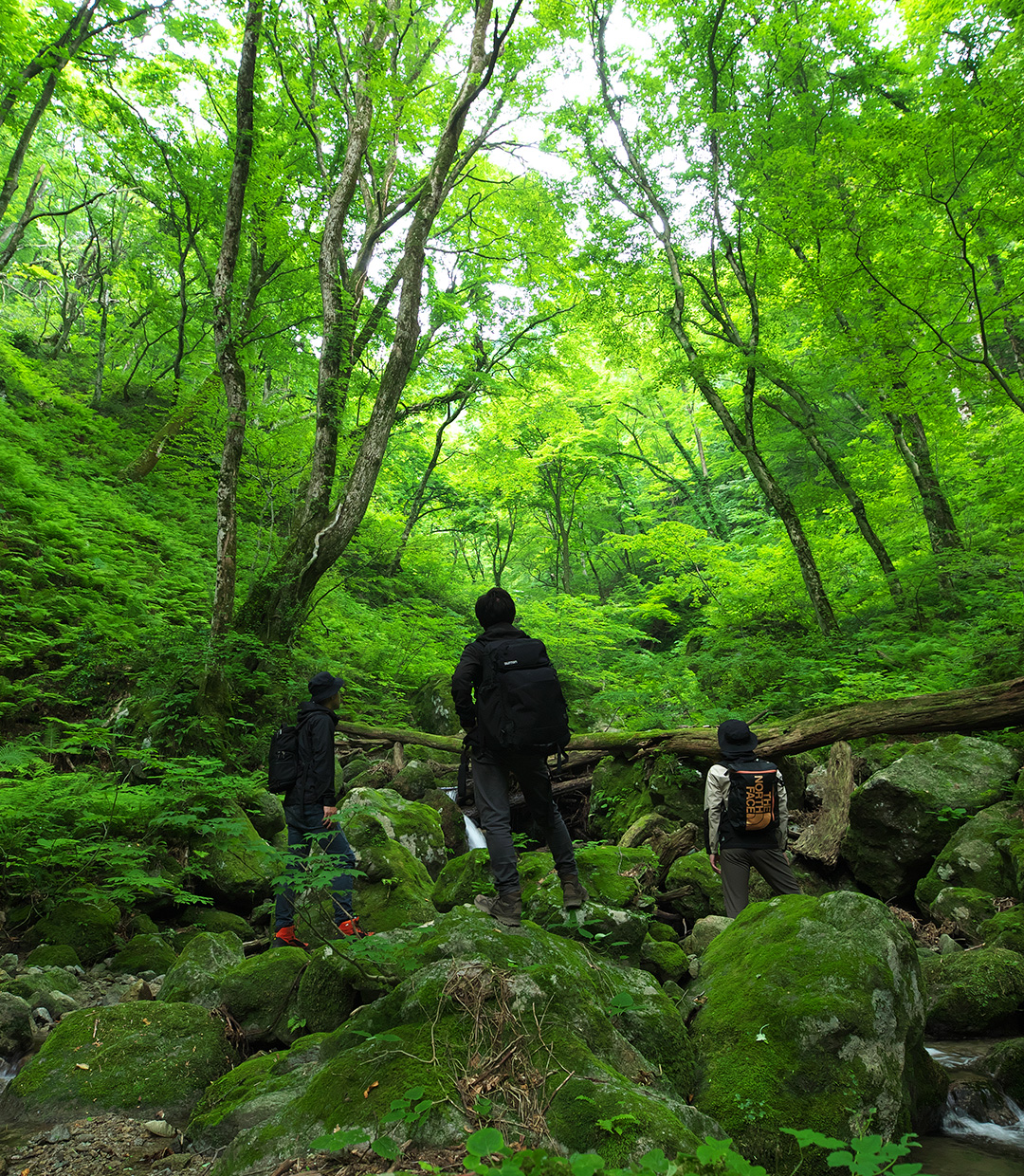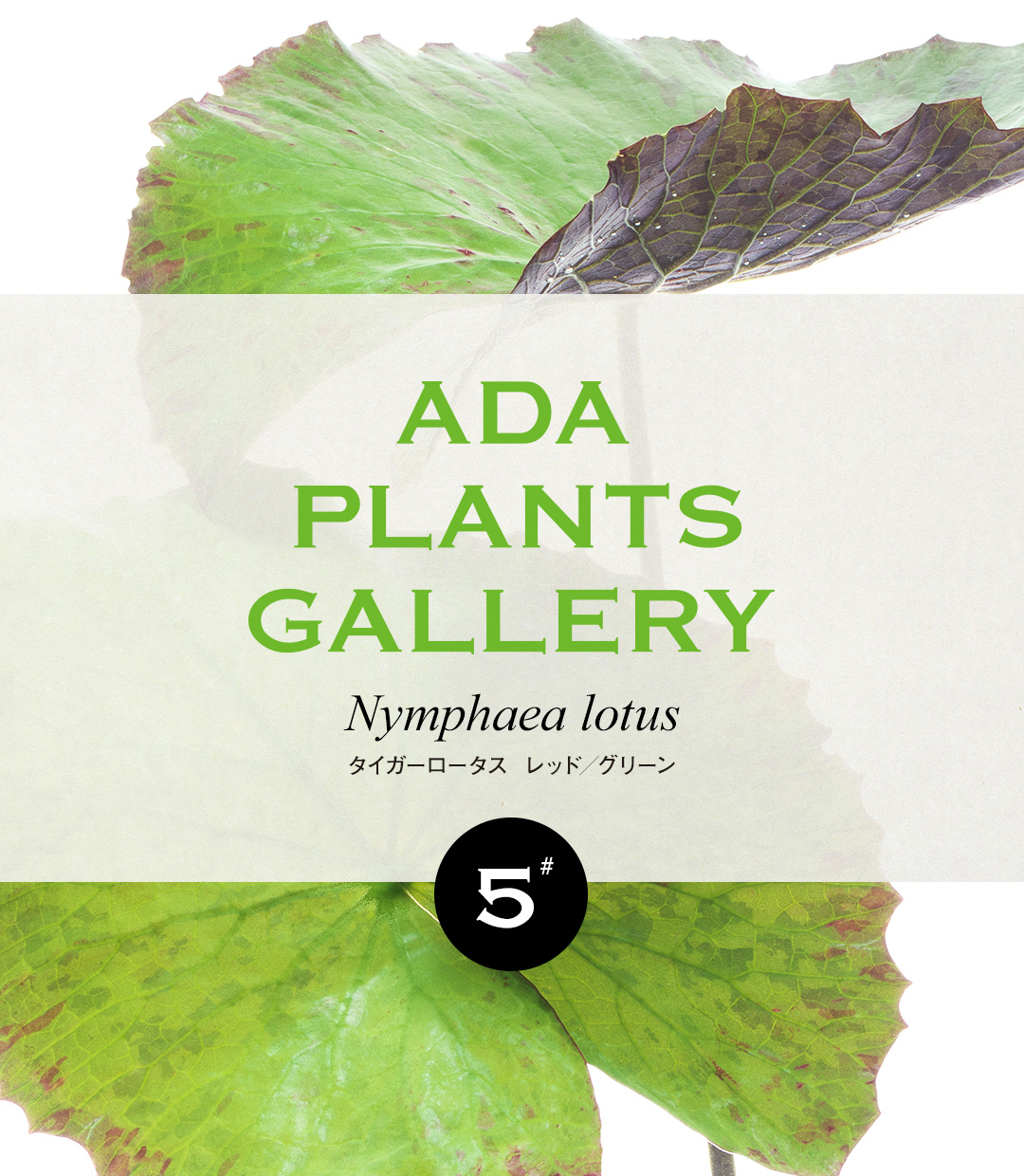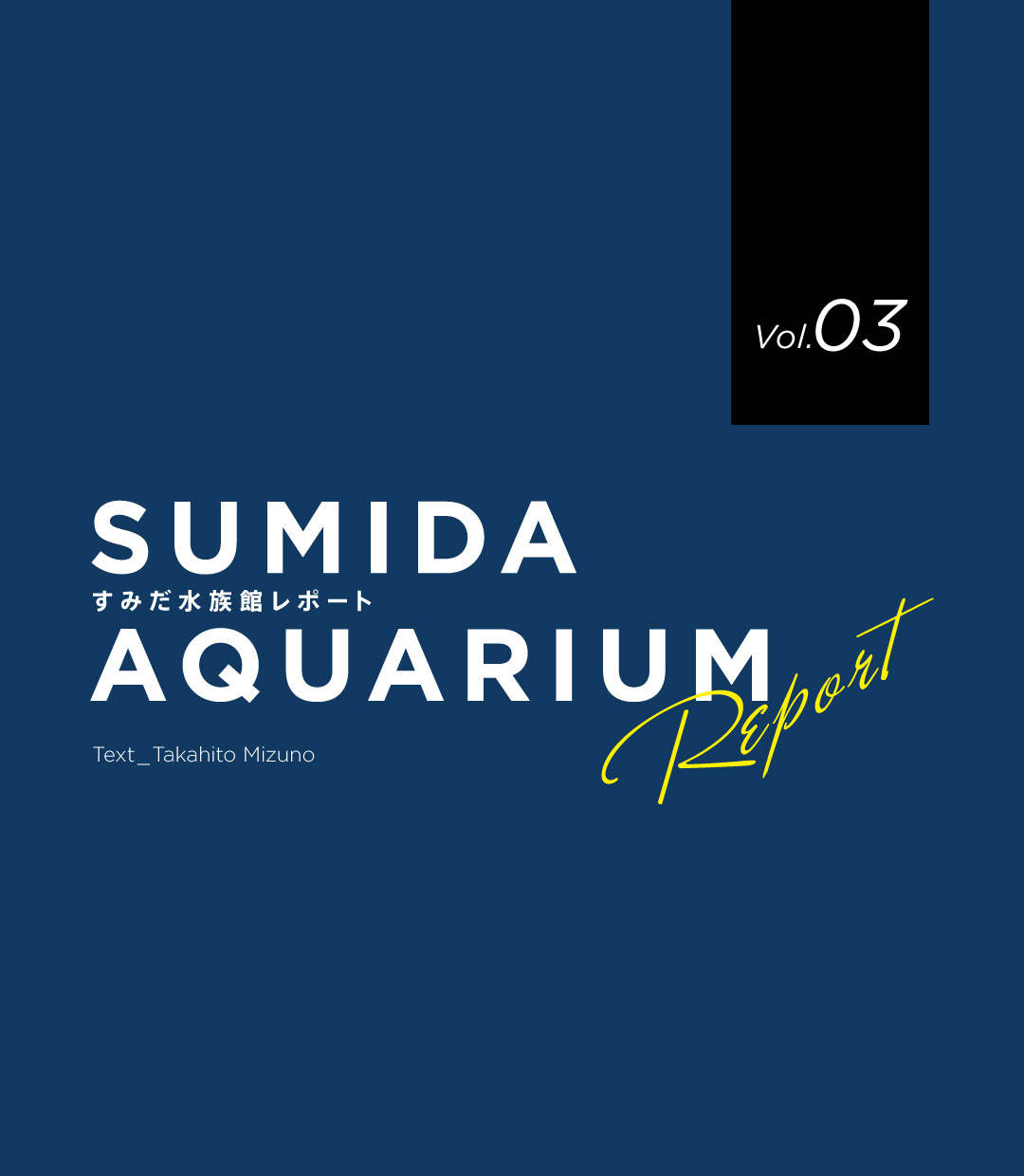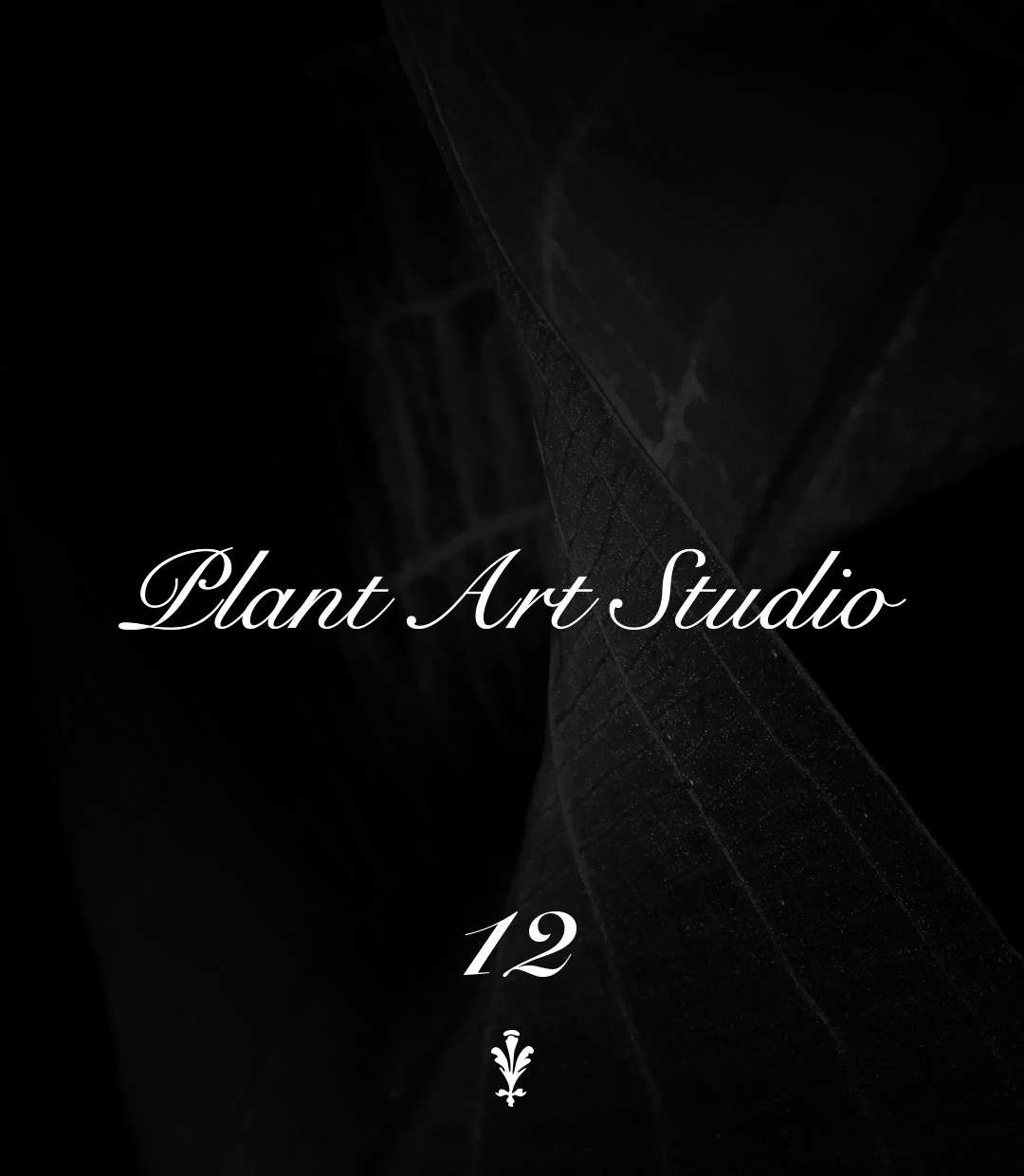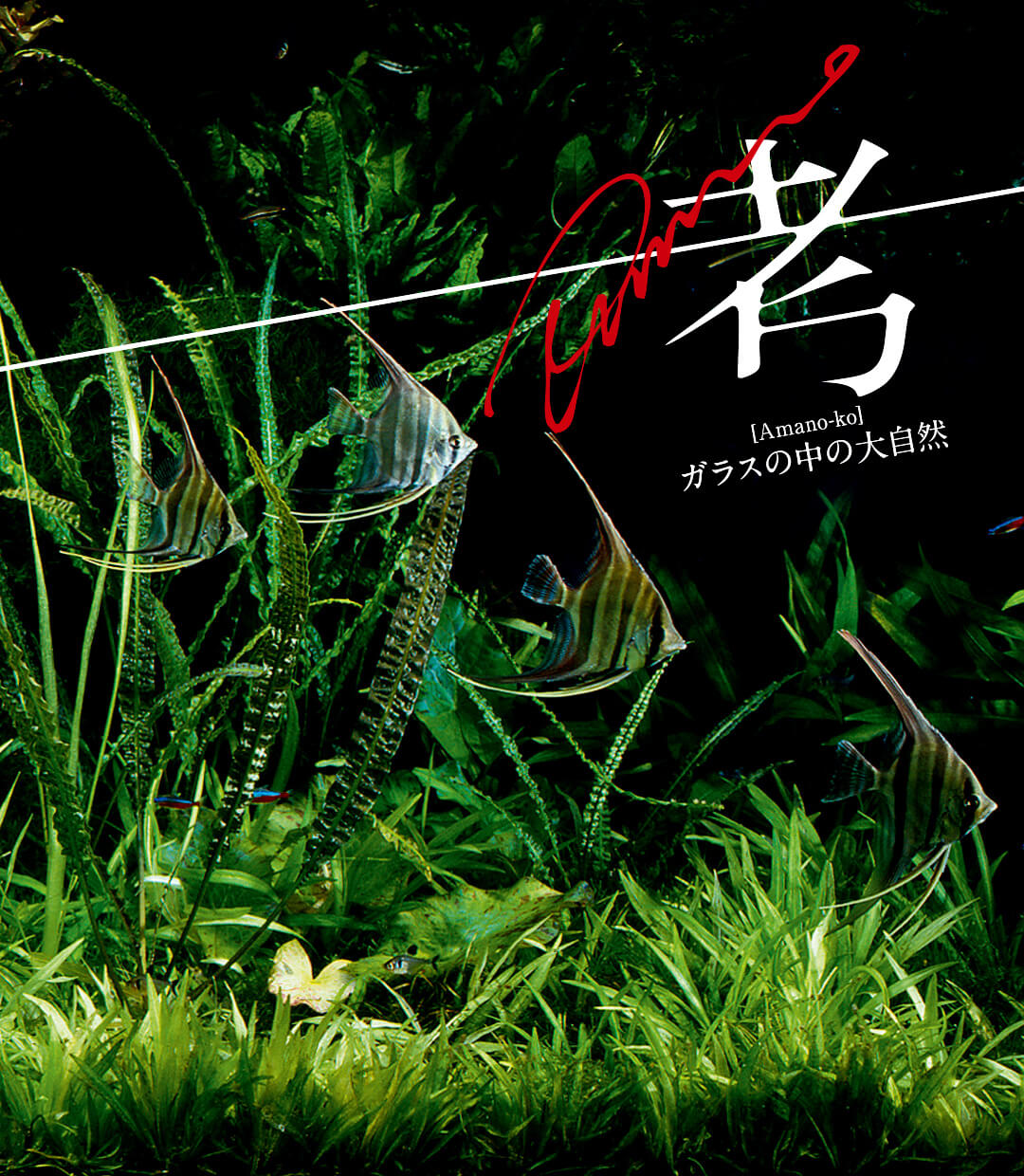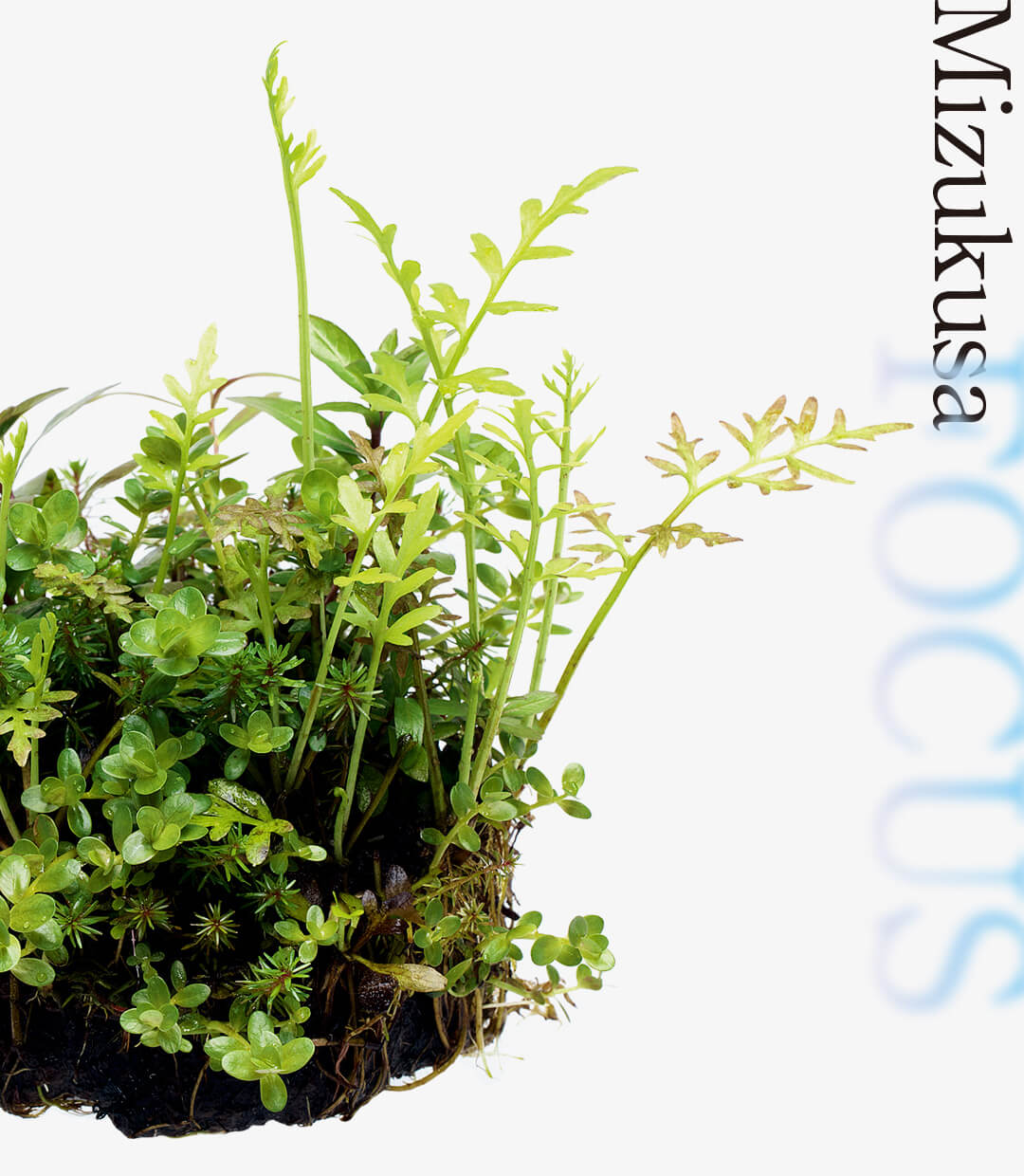NATURE IN THE GLASS ‘Blue After the Rain’
Elegance created over time, also becomes one of the important expression elements
Natural scenery changes daily and show us many expres-sions. I’m always moved by expressions and atmospheres of nature I unexpectedly come across. The natural stone arrangements I see in the mountain streams, the way moss grows, and a scene with fallen driftwood are typical examples. And they give us specific tips for layouts. When I think about why I am so attracted by such scenes, I realize that it’s simply because those landscapes are created by a huge amount of time. Although the time scale is different, the natural feeling and elegance is created by the long-term maintenance in Nature Aquarium. I try to cherish such effortless expressions too.
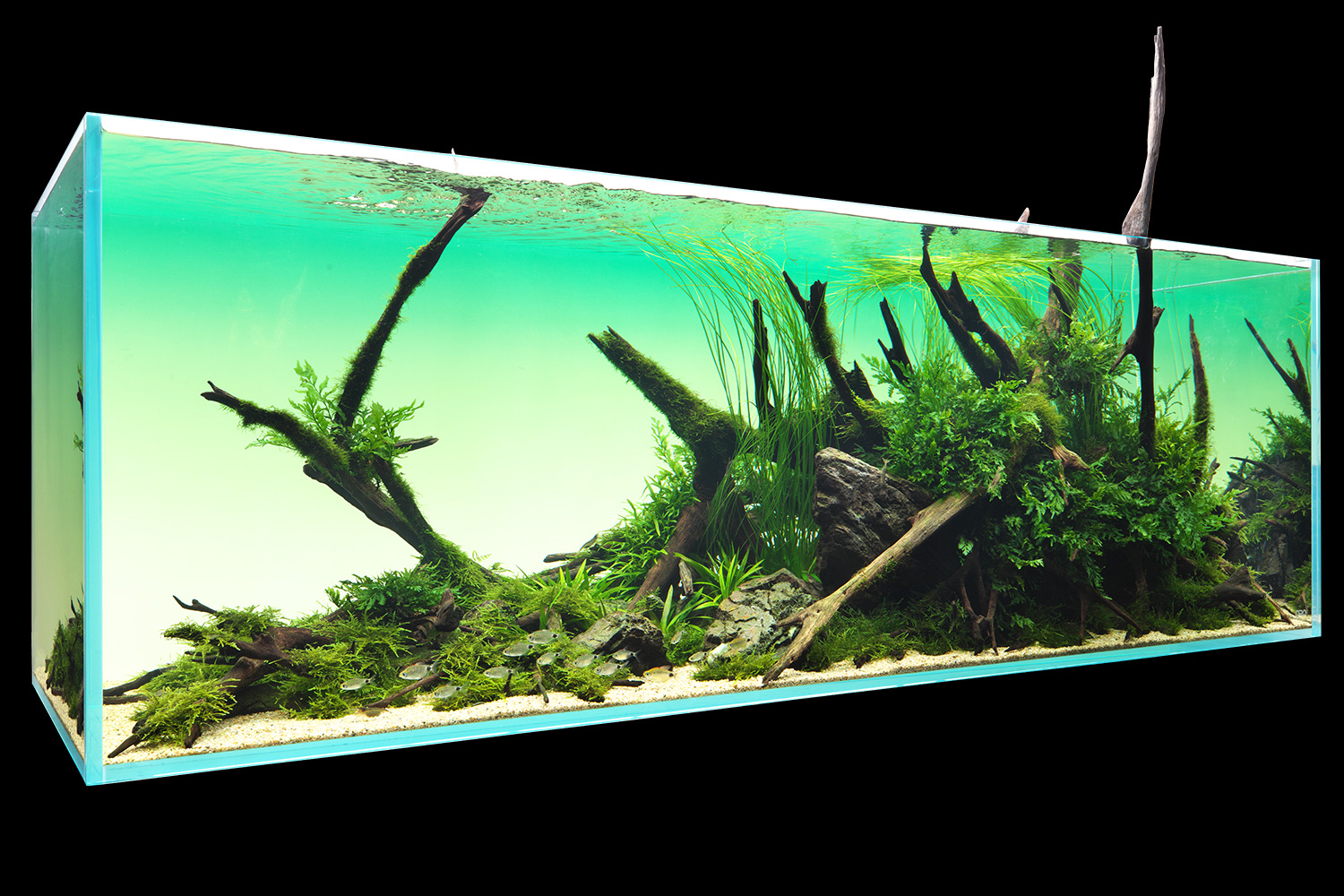
DATA
Shooting date: June 5th, 2021(ADA)
Creator: Yusuke Homma
Aquarium: Cube Garden W180×D60×H60(cm)
Lighting: Solar RGB x 3, turned on for 8.5 hours per day
Filter: Super Jet Filter ES-2400(Bio Rio L)
Material: Jati Wood, Manten Stone
Substrate: Colorado Sand, Aqua Soil – Amazonia Ver.2, Power Sand Advance L, Bacter100, Clear Super, Tourmaline BC
CO2: Pollen Glass Beetle 50Ø, 10 bubbles per second via CO2 Beetle Counter (using Tower)
Aeration: 15.5 hours after the light is turned off using Lily Pipe P-6
Additives: Brighty K, Green Brighty Mineral, Green Brighty Iron, Green Brighty Nitrogen
Water change: 1/2 once a week
Water quality: Temperature: 25ºC; pH: 6.2; TH: 20 mg/l
Plant
Eriocaulon sp. ‘Social Feather Duster’
Sagittaria graminea
Bolbitis heudelotii
Microsorum sp. ‘Trident’
Vesicularia sp.
Riccardia chamedryfolia
Taxiphyllum barbieri
Fish and Invertebrates
Phenacogrammus caudomaculatus
Crossocheilus oblongus
Otocinclus sp.
Caridina multidentata
Shooting date: June 5th, 2021(ADA)
Creator: Yusuke Homma
Aquarium: Cube Garden W180×D60×H60(cm)
Lighting: Solar RGB x 3, turned on for 8.5 hours per day
Filter: Super Jet Filter ES-2400(Bio Rio L)
Material: Jati Wood, Manten Stone
Substrate: Colorado Sand, Aqua Soil – Amazonia Ver.2, Power Sand Advance L, Bacter100, Clear Super, Tourmaline BC
CO2: Pollen Glass Beetle 50Ø, 10 bubbles per second via CO2 Beetle Counter (using Tower)
Aeration: 15.5 hours after the light is turned off using Lily Pipe P-6
Additives: Brighty K, Green Brighty Mineral, Green Brighty Iron, Green Brighty Nitrogen
Water change: 1/2 once a week
Water quality: Temperature: 25ºC; pH: 6.2; TH: 20 mg/l
Plant
Eriocaulon sp. ‘Social Feather Duster’
Sagittaria graminea
Bolbitis heudelotii
Microsorum sp. ‘Trident’
Vesicularia sp.
Riccardia chamedryfolia
Taxiphyllum barbieri
Fish and Invertebrates
Phenacogrammus caudomaculatus
Crossocheilus oblongus
Otocinclus sp.
Caridina multidentata
Feeling the eternal drama that nature creates from scenery
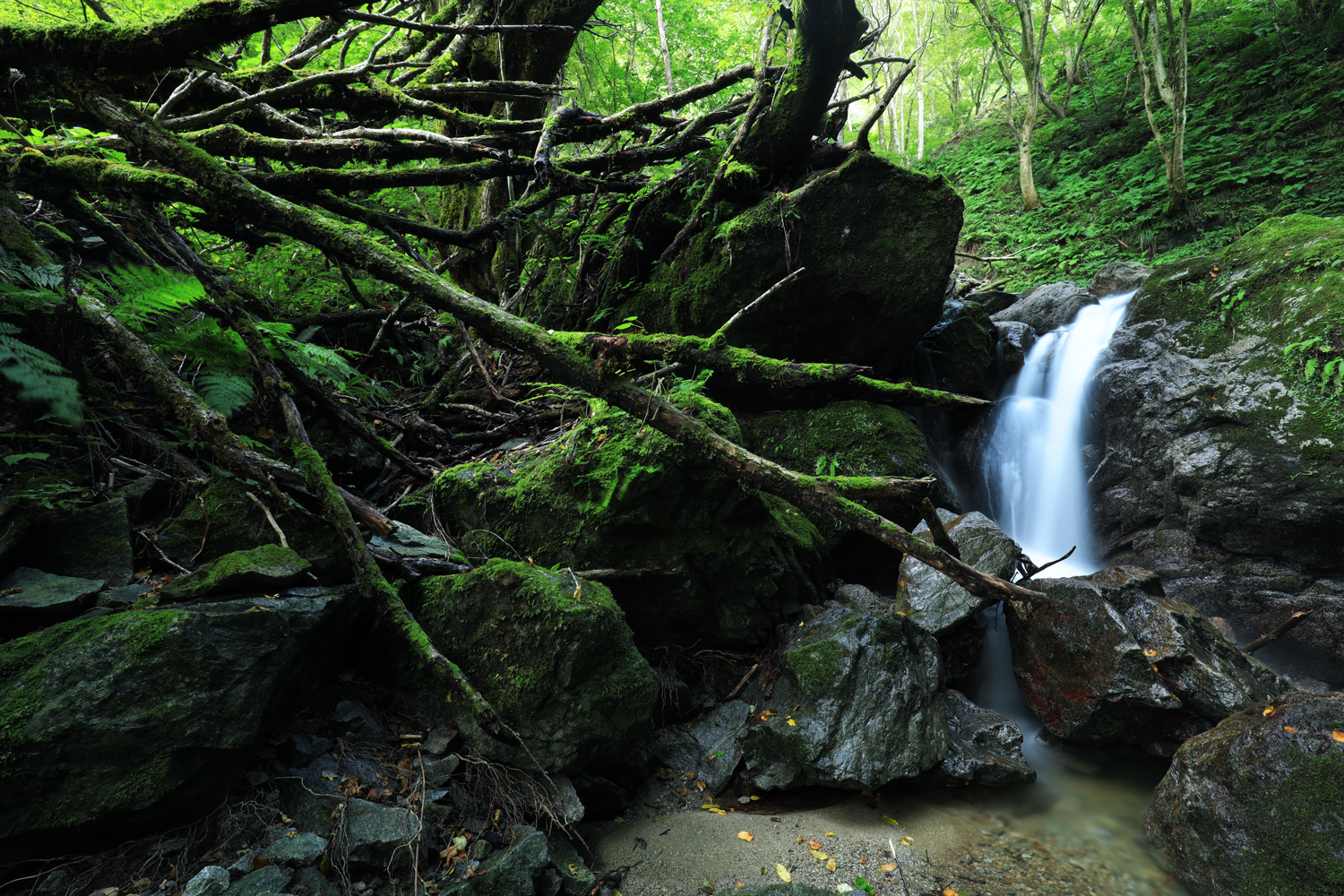
Nature that remains at the source of Miomote River
Miomote River located in the Bandai-Asahi National Park originates from the Asahi Mountain Range, and has been known for the salmon run for a long time. The beauty of the Miomote River full of water in each season is exceptional, and there are wild landscapes in its tributaries and the surrounding primeval forest even now. The first time I visited the place was about 20 years ago when I accompanied Takashi Amano to the field photoshoot. In particular, since 5 or 6 years ago, I’ve been visiting there in each season and taking pictures. The rugged atmosphere that keeps people away is just right to call it a sanctuary. Because the road to the photo spot is difficult, and people don’t get too close to the place, the beautiful landscapes may be remained even until now.
Miomote River located in the Bandai-Asahi National Park originates from the Asahi Mountain Range, and has been known for the salmon run for a long time. The beauty of the Miomote River full of water in each season is exceptional, and there are wild landscapes in its tributaries and the surrounding primeval forest even now. The first time I visited the place was about 20 years ago when I accompanied Takashi Amano to the field photoshoot. In particular, since 5 or 6 years ago, I’ve been visiting there in each season and taking pictures. The rugged atmosphere that keeps people away is just right to call it a sanctuary. Because the road to the photo spot is difficult, and people don’t get too close to the place, the beautiful landscapes may be remained even until now.
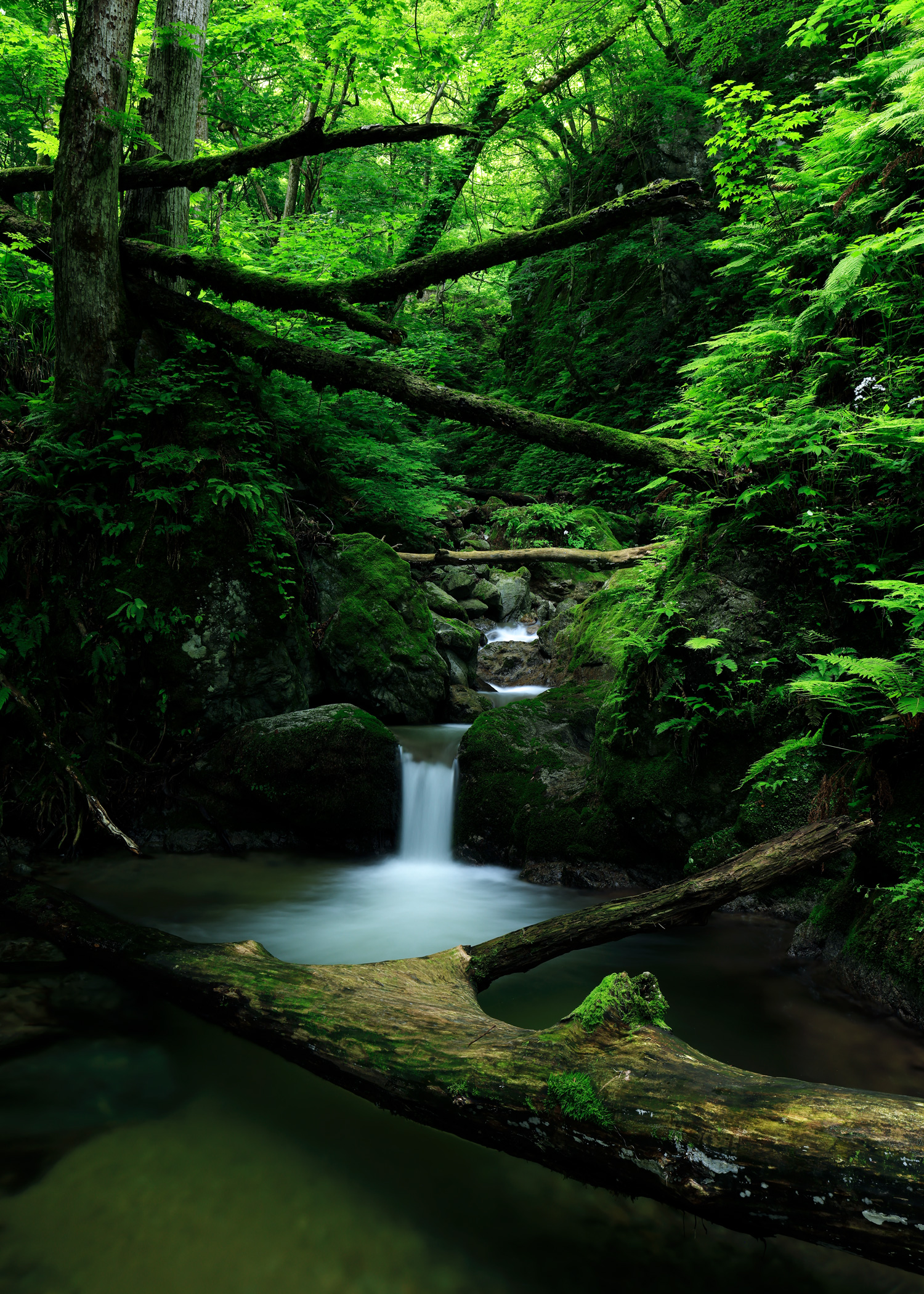
Following the law of nature
Because the height of trees deep in the forest becomes tall, the light that shines into the valley is extremely little. As a result, there are more shade tolerant plants like ferns in the area. When trying to express the atmosphere in an aquarium tank, I primarily use ferns and several types of moss to show the passage of time. And to create an atmosphere of the mountain stream and a refreshing feeling, I finish it simple with tape shape aquatic plants. I would like to make the most of the charms of materials like shapes of stones and driftwood, and aquatic plant species that I use. I try not to make unreasonable planting or expressions by following the law of nature.
Because the height of trees deep in the forest becomes tall, the light that shines into the valley is extremely little. As a result, there are more shade tolerant plants like ferns in the area. When trying to express the atmosphere in an aquarium tank, I primarily use ferns and several types of moss to show the passage of time. And to create an atmosphere of the mountain stream and a refreshing feeling, I finish it simple with tape shape aquatic plants. I would like to make the most of the charms of materials like shapes of stones and driftwood, and aquatic plant species that I use. I try not to make unreasonable planting or expressions by following the law of nature.
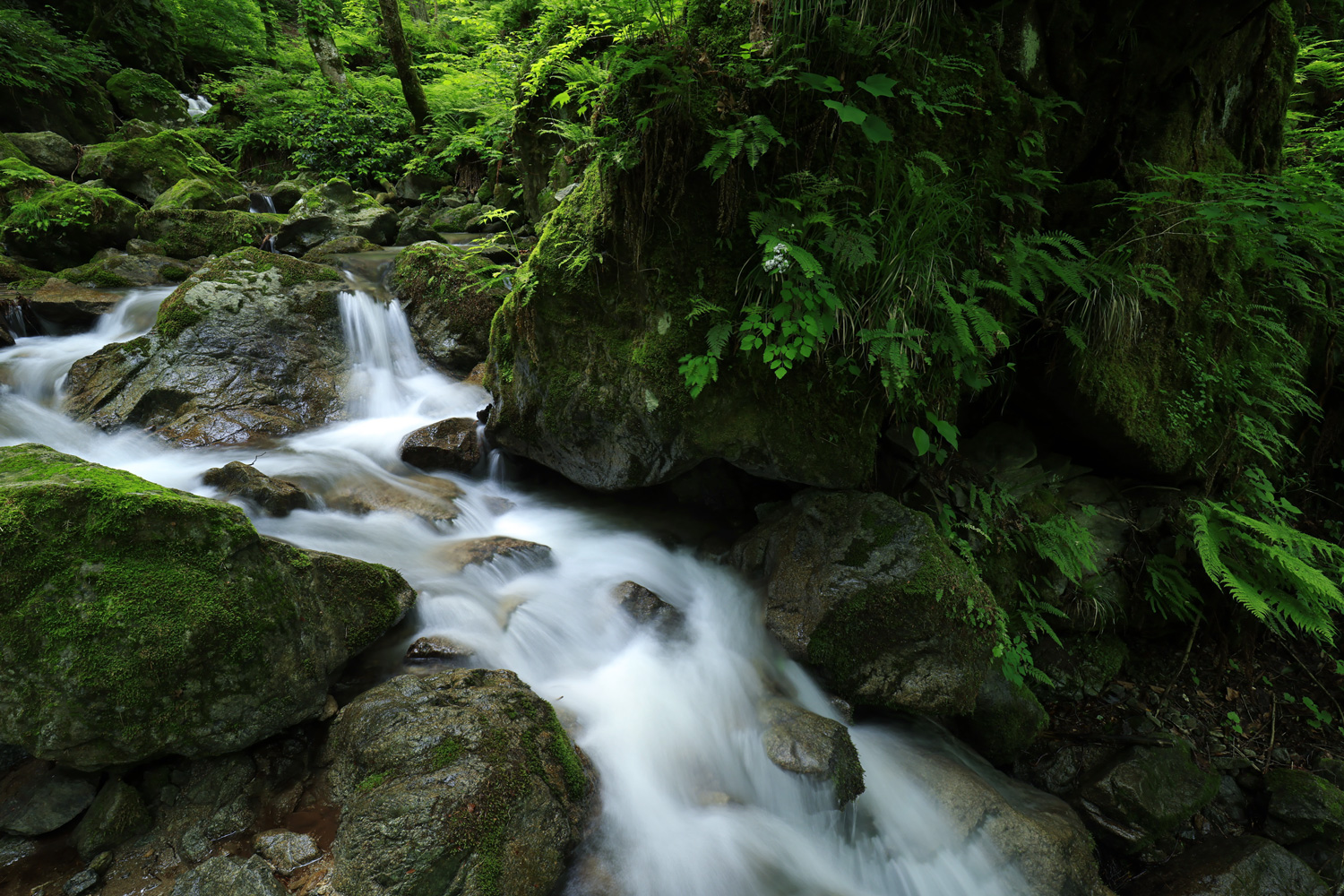
Relationship between rocks and water flow
The power of water flow in the mountain stream brought by spring thaw water and heavy rain is tremendous, and even stones that humans are unable to move can be easily washed away. When I go out to fields after a long time, most of the time, the directions of stones and the flow of the river are different compared to before. However, large rocks don’t change their shapes and continue to exist there in such a situation. By having something that doesn’t move or stays the same even in nature changing daily, the structure is kept as a landscape, and the beautiful scenery is formed.
Never forgetting the stance to learn from nature
Although I visited this place many times, I have never seen the same landscape. By visiting there many times, I can see various changes in nature and learn something new every time I visit there. By looking at not just the magnificent scenery but also the directions of stones in the mountain stream and locations where ferns take root, the details in nature can be incorporated as one of the expressions when creating an aquascape.
The power of water flow in the mountain stream brought by spring thaw water and heavy rain is tremendous, and even stones that humans are unable to move can be easily washed away. When I go out to fields after a long time, most of the time, the directions of stones and the flow of the river are different compared to before. However, large rocks don’t change their shapes and continue to exist there in such a situation. By having something that doesn’t move or stays the same even in nature changing daily, the structure is kept as a landscape, and the beautiful scenery is formed.
Never forgetting the stance to learn from nature
Although I visited this place many times, I have never seen the same landscape. By visiting there many times, I can see various changes in nature and learn something new every time I visit there. By looking at not just the magnificent scenery but also the directions of stones in the mountain stream and locations where ferns take root, the details in nature can be incorporated as one of the expressions when creating an aquascape.
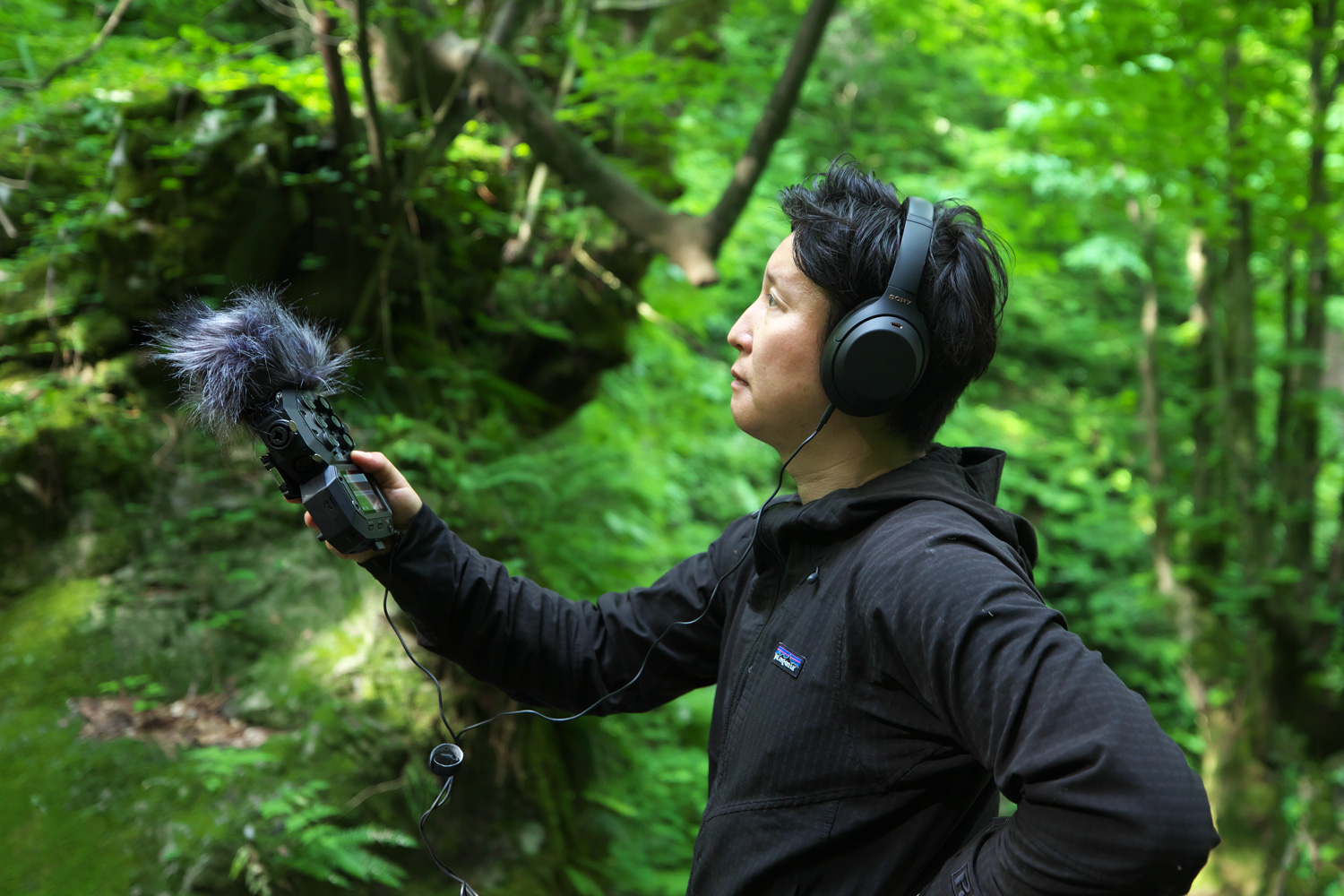
The leader of ADA SUIKEI creators. Conveying the charms of nature through Nature Aquarium by taking advantage of his experiences in the fields.
Feeling with your ears
Nowadays, I record sounds on site besides taking pictures. I believe that the information you get only with your hearing, makes your sensory sharpened without getting caught by other senses. As a result, it becomes possible for us to find out even the small details of nature. You notice that the sound of water changes depending on the angles of stones and the depth of water, and you can even feel the size of the space by how the sound of wind and insects echoes. It is so delightful to bring back the recorded sounds of nature and listen to the sounds at home. I would be happy if there is an opportunity for me to share the recorded sounds with you at future events etc.
Nowadays, I record sounds on site besides taking pictures. I believe that the information you get only with your hearing, makes your sensory sharpened without getting caught by other senses. As a result, it becomes possible for us to find out even the small details of nature. You notice that the sound of water changes depending on the angles of stones and the depth of water, and you can even feel the size of the space by how the sound of wind and insects echoes. It is so delightful to bring back the recorded sounds of nature and listen to the sounds at home. I would be happy if there is an opportunity for me to share the recorded sounds with you at future events etc.
Visualizing a brief expression of nature
By taking advantage of the open flow of the Nature Aquarium gallery, the composition makes it possible for us to see the light and shadow parts found in nature and enjoy the aquarium tank from the front and back. For that reason, material selection is also important. So I chose straight driftwood pieces suitable for the impression that I wanted to express, and created the composition in a way that people can feel the directions of light and the flow of water clearly. Just like running into an expression for a moment in the natural scenery, finding composition materials like driftwood and stones suitable for your imagination is an important element. Encountering the scenery with the stones and driftwood in the Miomote River, located in Murakami City, Niigata where I got inspirations for this layout, and encountering the composition materials that match my imagination, it can be said that the both encounters motivated me to create this layout.
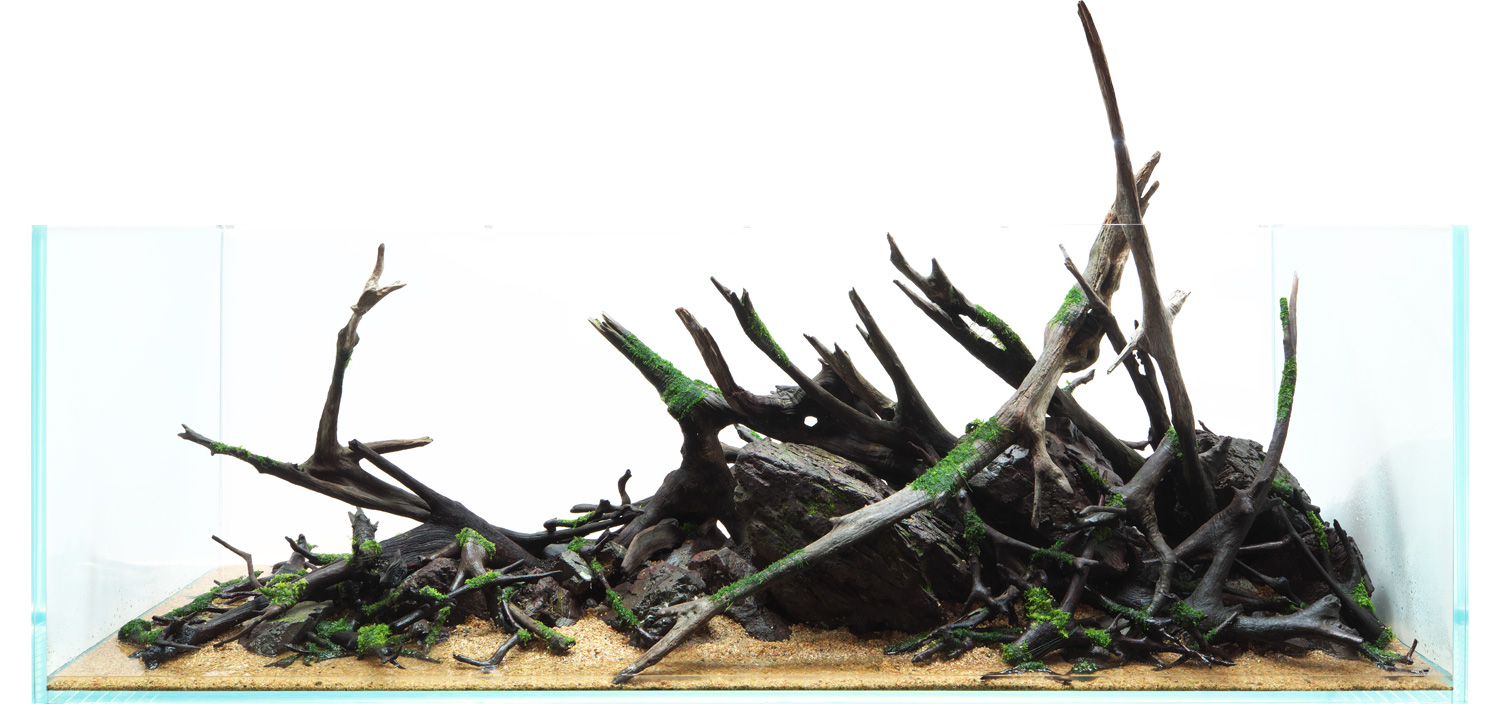
Photo taken on June 30th, 2020
1.Use of straight driftwood
While having a large main stone as an axis, straight driftwood pieces were arranged in a way that they were entangled. By doing so, the triangular composition was well utilized, and the flow going toward the open space is effectively emphasized. For such a powerful composition, it is important to leave a gap too.
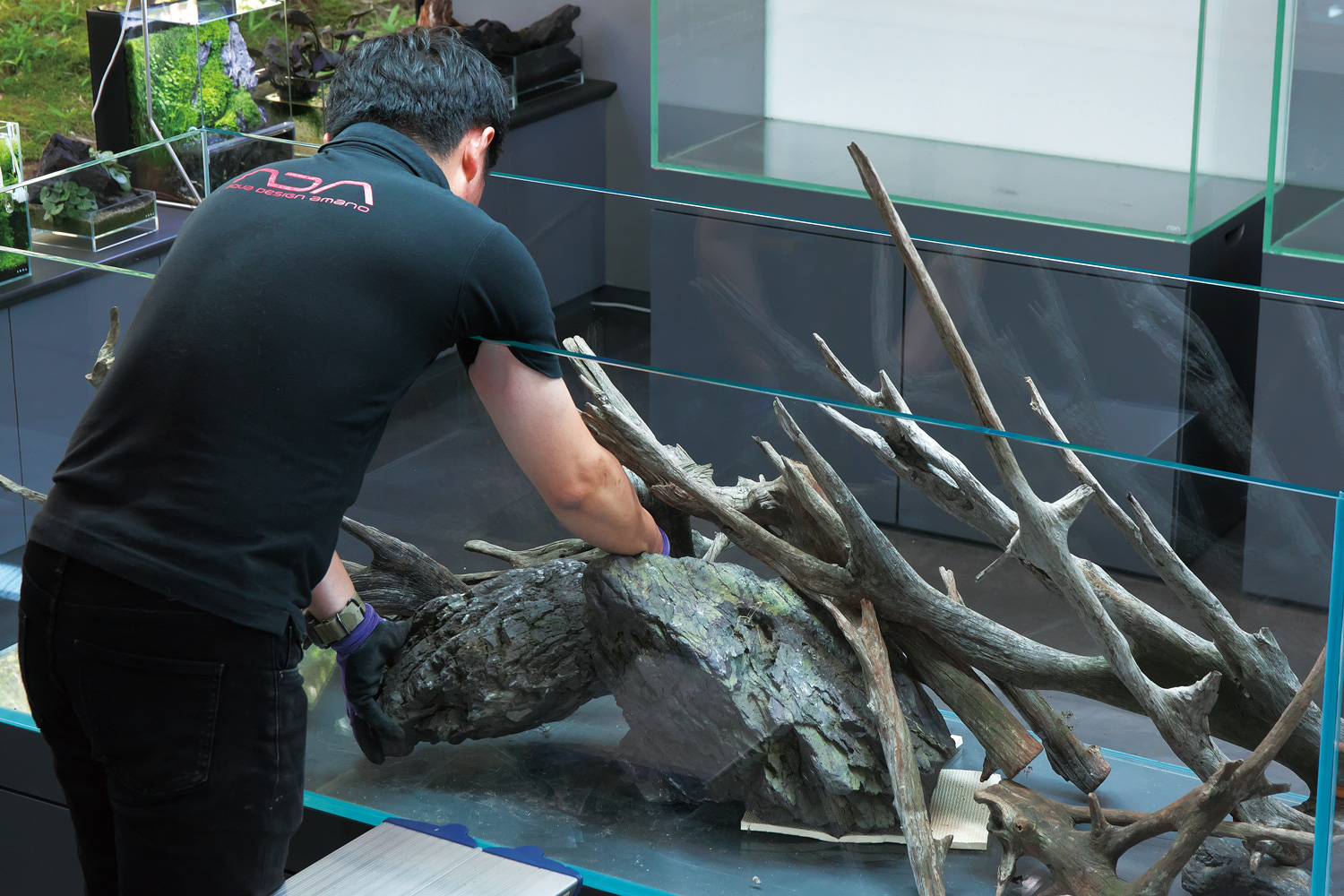
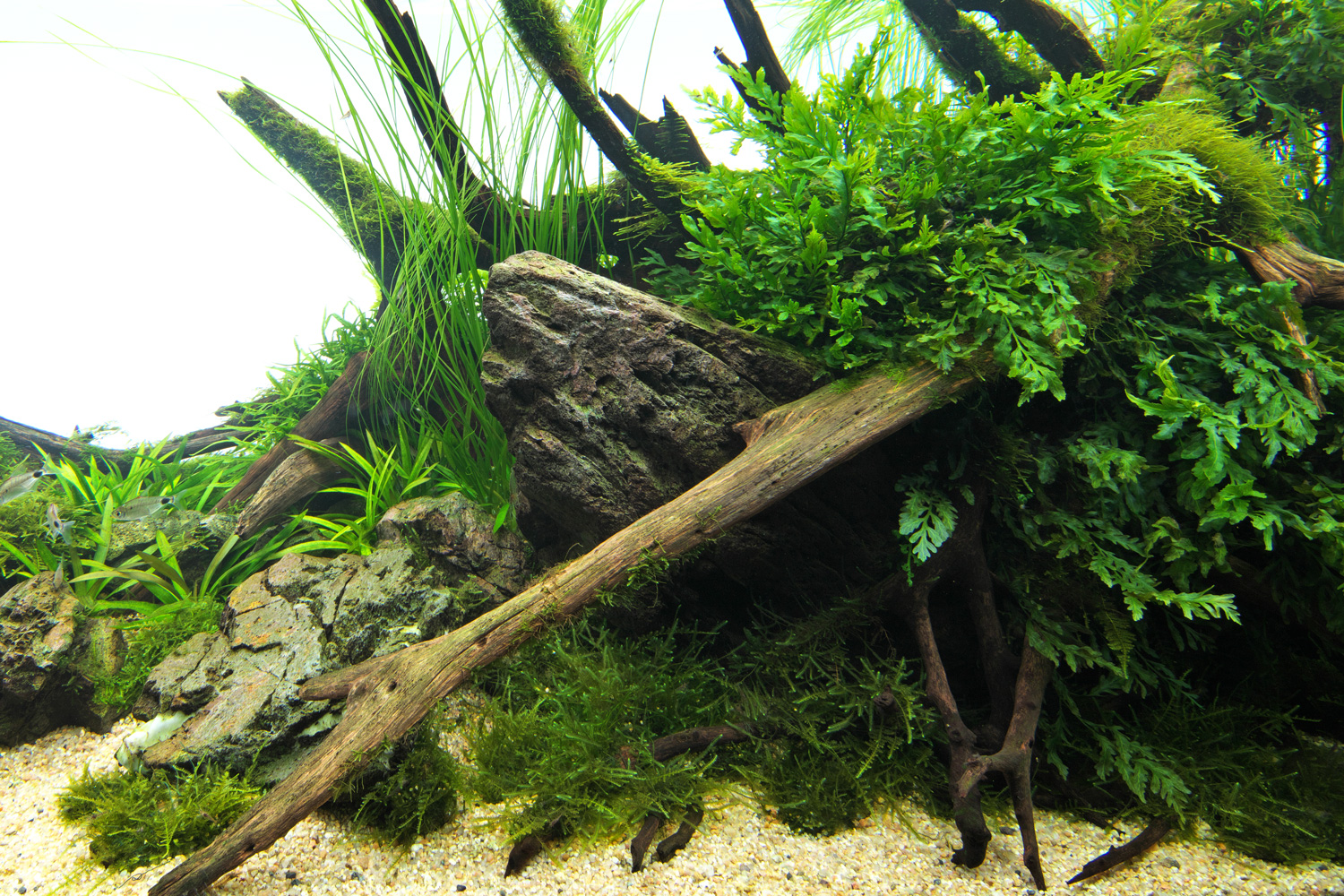
2. Planting tape type aquatic plants
I emphasized the underwater feeling by pouring Amazonia Ver.2 into gaps between stones and driftwood and planting Eriocaulon sp. ‘Social Feather Duster’. I initially had a plan of using short aquatic plants in order to keep the open space section. But, if choosing Echinodorus tenellus, it grows in a cluster like a clump, and the impression fades. Therefore, I planted Sagittaria graminea with large leaves and clarify its presence.
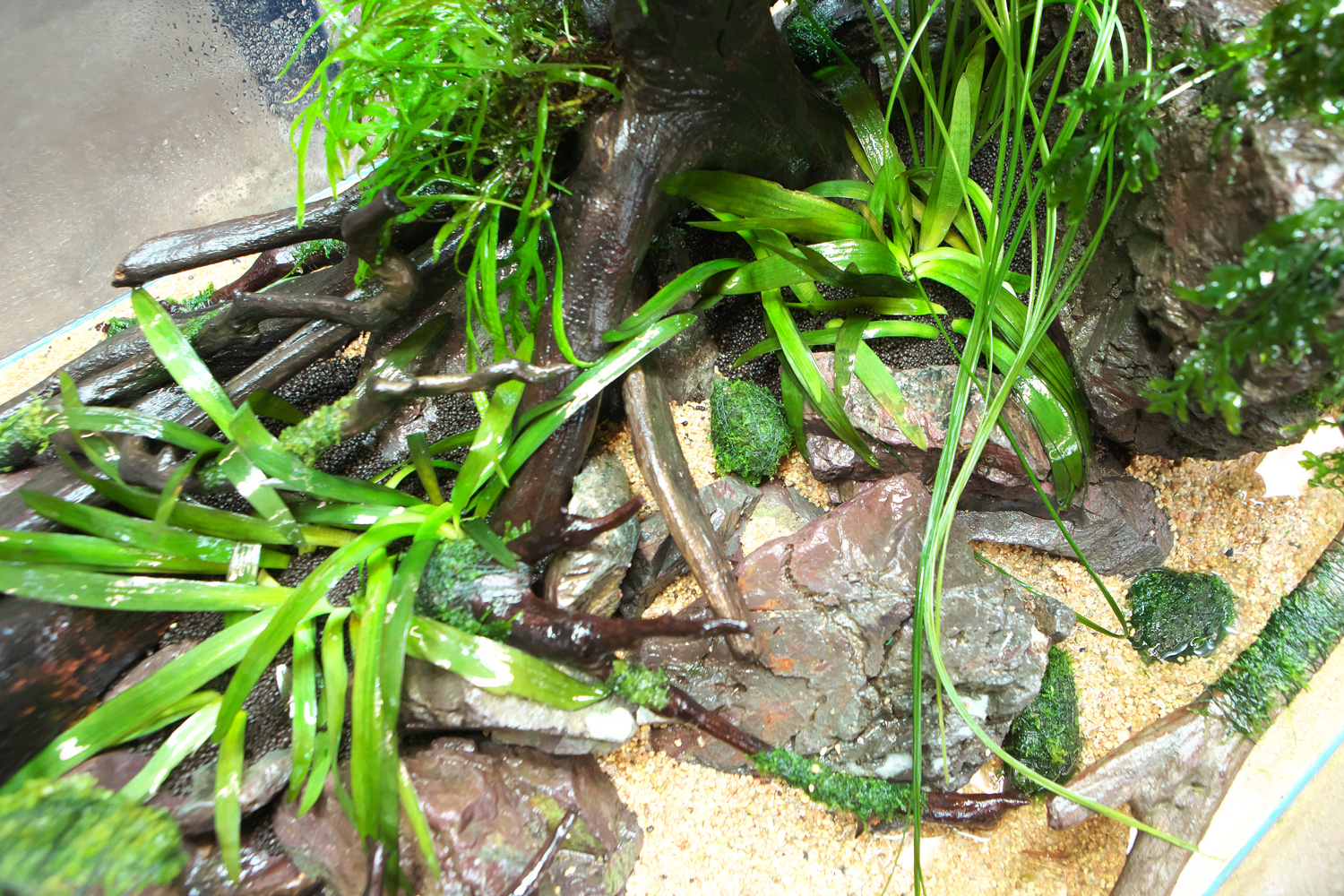
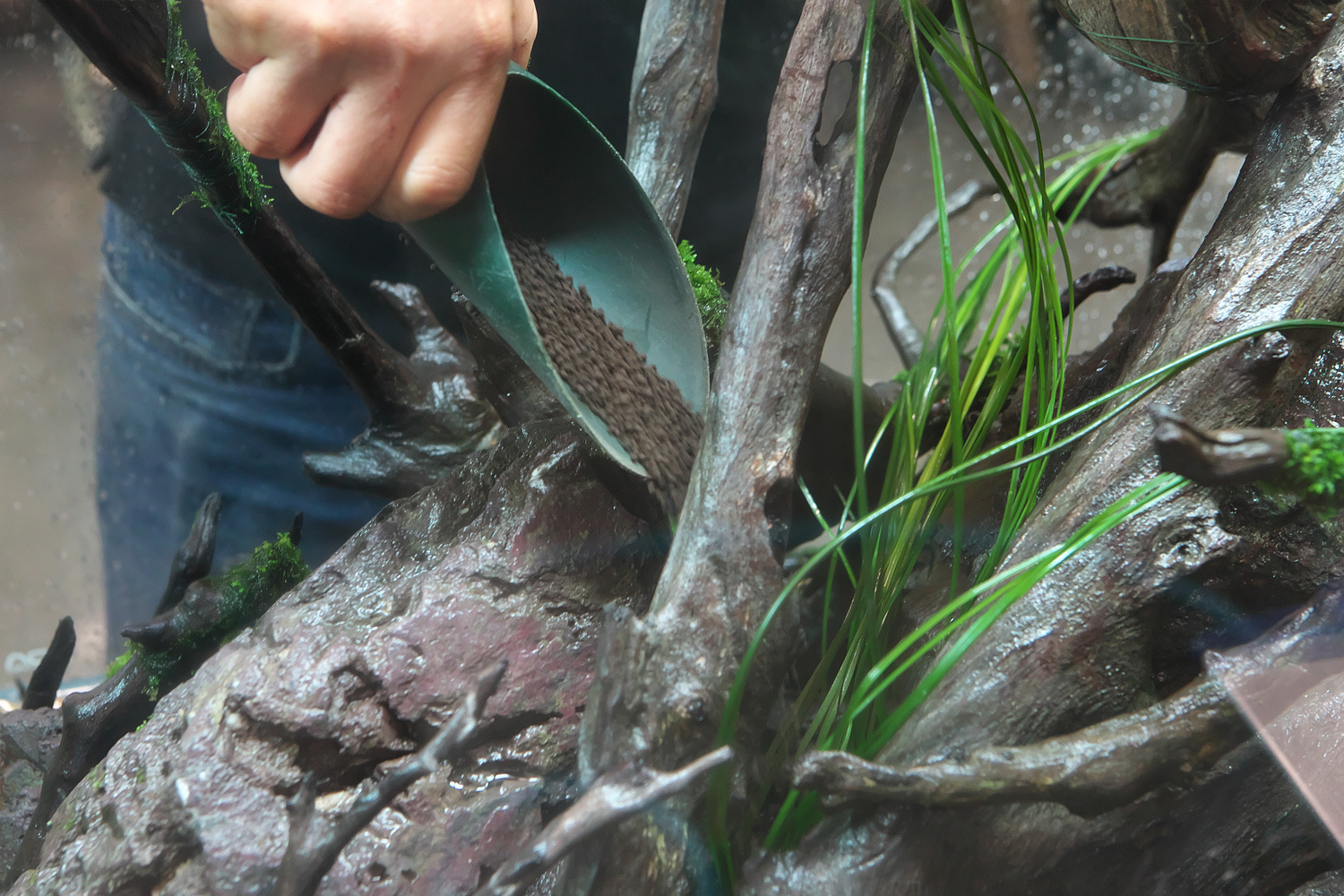
3. Proper use of different ferns
I mainly attached Bolbitis. But, because I wanted to give a bright impression to the layout when looking at it from the back side, I had Microsorum sp. ‘Trident’ grow in the part exposed to light as an accent. I gave contrasts by creating bright parts and dark parts depending on the colors of the leaves.
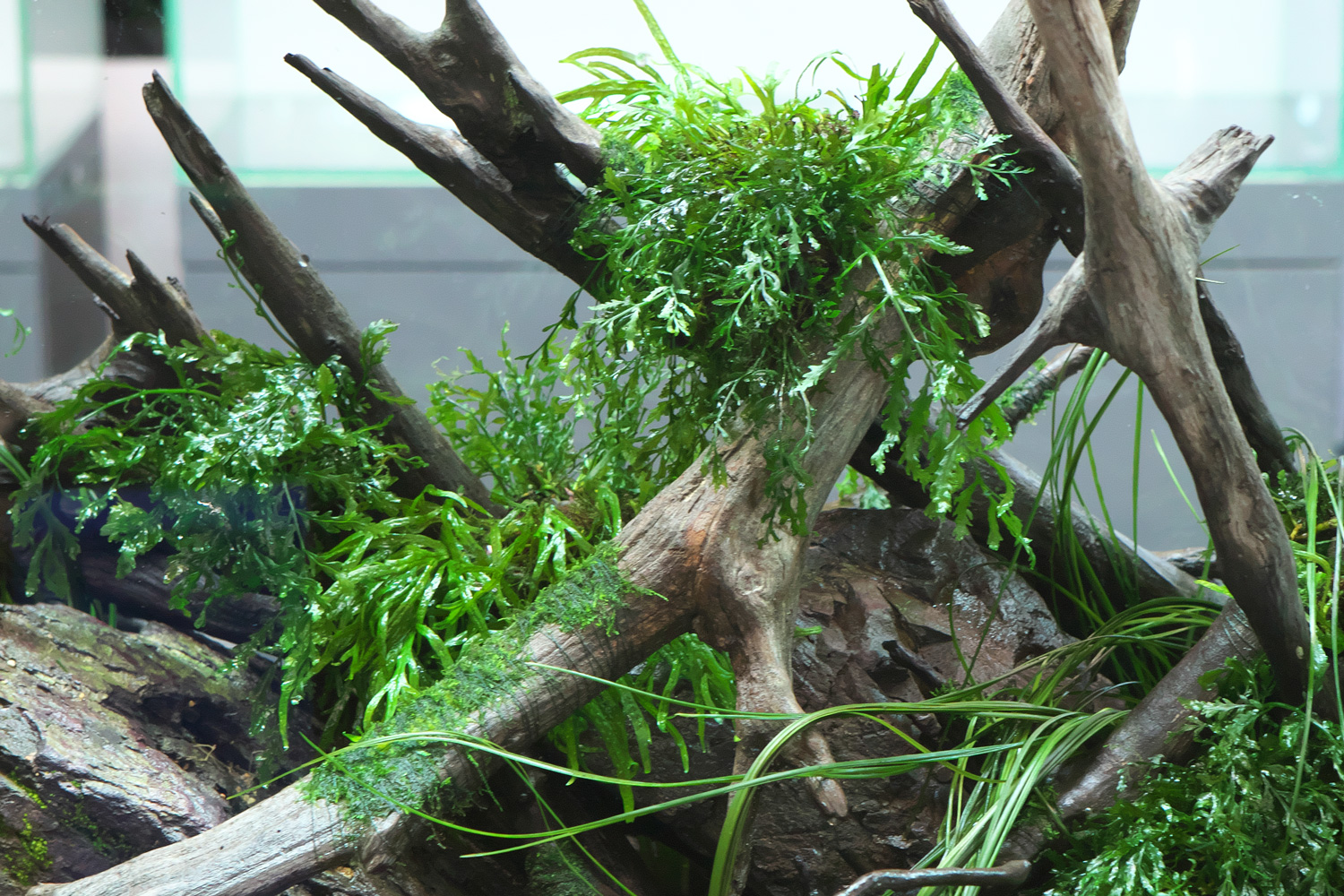
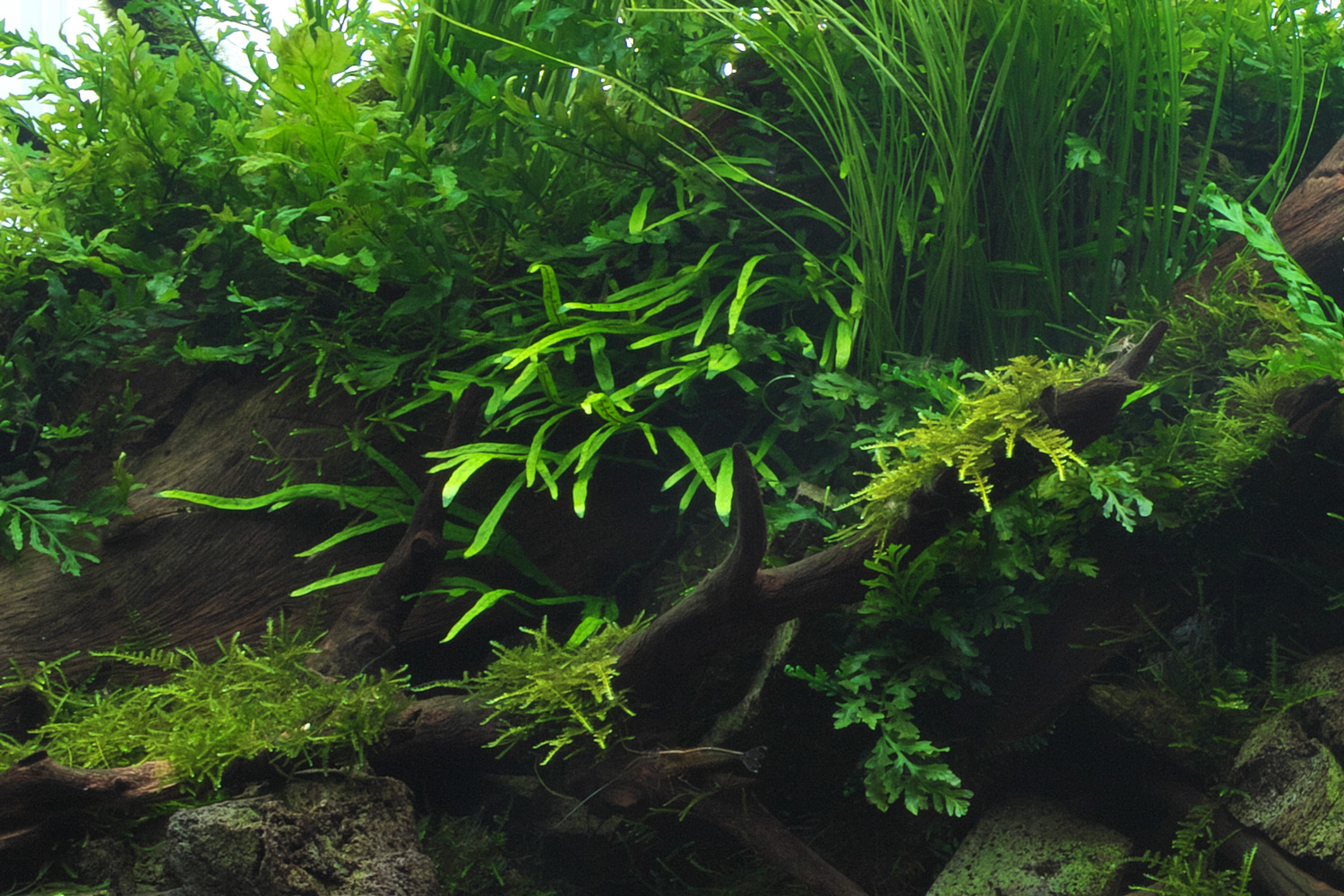

ⒸAQUA DESIGN AMANO
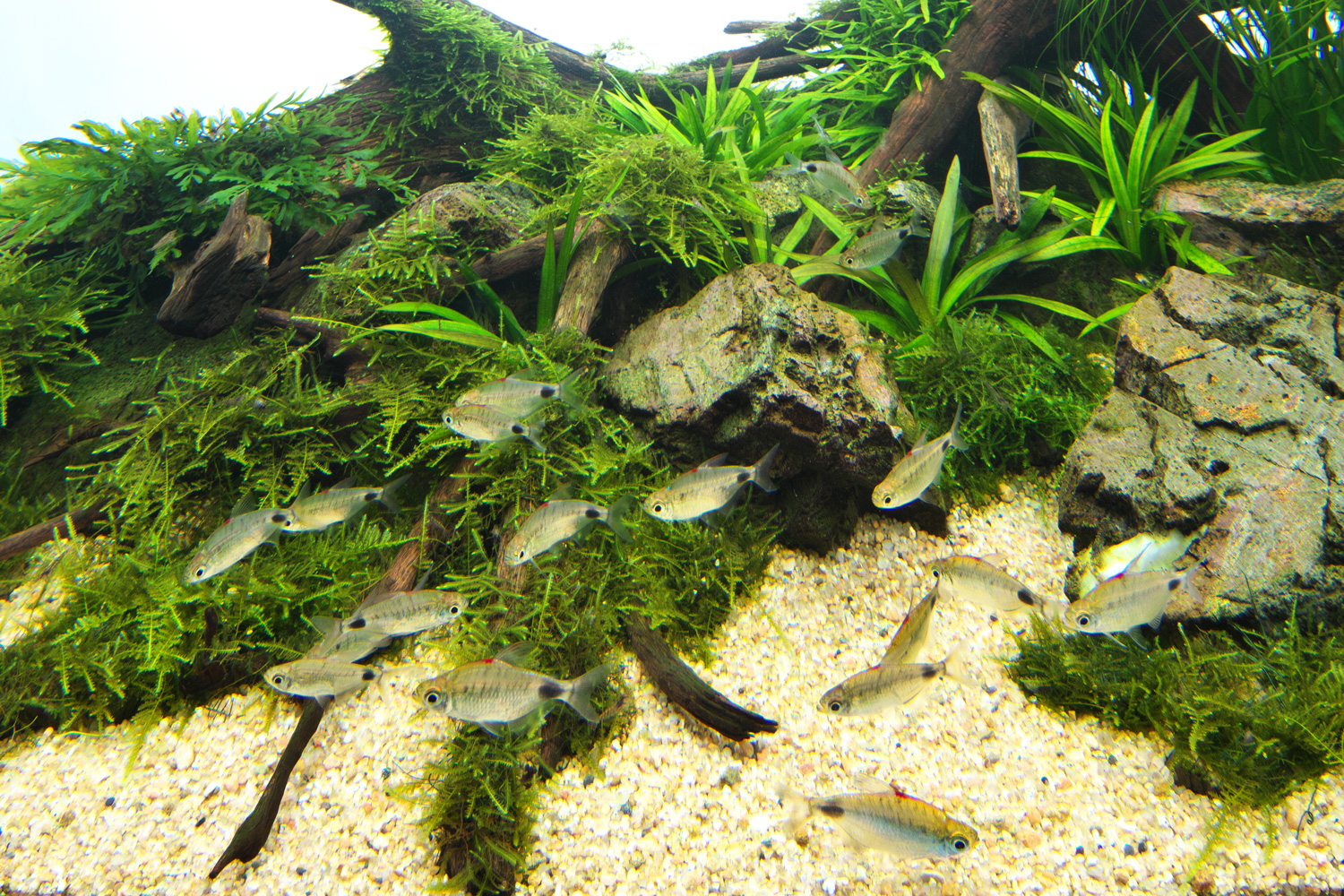
Expressing the passage of time and shadow
I expressed the flora of the mountain stream and the passage of many years by primarily planting ferns such as Bolbitis and Microsorum. I created an aspect where driftwood decayed, and pieces of the decayed driftwood were scattered in the cosmetic sand area. Because small pieces of driftwood were easy to float on water, I checked if they would sink in water beforehand, and attached the same type of moss as the one on the main driftwood.
I expressed the flora of the mountain stream and the passage of many years by primarily planting ferns such as Bolbitis and Microsorum. I created an aspect where driftwood decayed, and pieces of the decayed driftwood were scattered in the cosmetic sand area. Because small pieces of driftwood were easy to float on water, I checked if they would sink in water beforehand, and attached the same type of moss as the one on the main driftwood.

Expressing yin and yang with the inclination of driftwood
I gave a powerful look to the aquascape by creating shadowy areas with many pieces of driftwood tilted toward the front in the front area. On the other hand, I made the back side get a lot of light by tilting the driftwood pieces toward the front. As a result, two expressions can be enjoyed in one aquascape. When the aquascape is viewed from the sides, the inclination of the driftwood is even more obvious.
I gave a powerful look to the aquascape by creating shadowy areas with many pieces of driftwood tilted toward the front in the front area. On the other hand, I made the back side get a lot of light by tilting the driftwood pieces toward the front. As a result, two expressions can be enjoyed in one aquascape. When the aquascape is viewed from the sides, the inclination of the driftwood is even more obvious.

Expressing the water of a clear river and light
I recreated the refreshing impression of the mountain stream by scattering stones of various sizes in most parts. By spreading Colorado Sand suitable for the dark green color of Bolbitis and making it look like gravel in the mountain stream, the clear water area was effectively expressed.
I recreated the refreshing impression of the mountain stream by scattering stones of various sizes in most parts. By spreading Colorado Sand suitable for the dark green color of Bolbitis and making it look like gravel in the mountain stream, the clear water area was effectively expressed.
